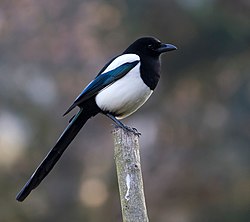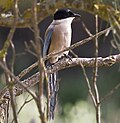Magpie
 From Wikipedia - Reading time: 13 min
From Wikipedia - Reading time: 13 min
| Magpie | |
|---|---|

| |
| Eurasian magpie | |
| Scientific classification | |
| Kingdom: | Animalia |
| Phylum: | Chordata |
| Class: | Aves |
| Order: | Passeriformes |
| Superfamily: | Corvoidea |
| Family: | Corvidae |
| Groups included | |
| Cladistically included but traditionally excluded taxa | |
Magpies are birds of various species of the family Corvidae. Like other members of their family, they are widely considered to be intelligent creatures. The Eurasian magpie, for instance, is thought to rank among the world's most intelligent creatures,[1][2] and is one of the few nonmammalian species able to recognize itself in a mirror test.[3] Magpies have shown the ability to make and use tools, imitate human speech, grieve, play games, and work in teams.[4] They are particularly well known for their songs and were once popular as cagebirds. In addition to other members of the genus Pica, corvids considered magpies are in the genera Cissa, Urocissa, and Cyanopica.
Magpies of the genus Pica are generally found in temperate regions of Europe, Asia, and western North America, with populations also present in Tibet and high-elevation areas of Kashmir. Magpies of the genus Cyanopica are found in East Asia and the Iberian Peninsula. The birds called magpies in Australia are, however, not related to the magpies in the rest of the world.[5]
Name
[edit]The name is a combination of "mag" and "pie". The "pie" part of the name derives from an earlier name for the animal that can be traced back to the PIE root *(s)peik-. Itself possible derived from the PIE root *pi, implying pointedness. Possibly in reference to its pointed beak, or its long tail.[6] The tendency in previous centuries was to give birds common names, such as robin redbreast (which now is called the robin) and jenny wren. The magpie was originally variously maggie pie and mag pie.[6][7] The term "pica" for the human disorder involving a compulsive desire to eat items that are not food is borrowed from the Latin name of the magpie, pica, for its reputed tendency to feed on miscellaneous things.[8]
Systematics and species
[edit]According to some studies, magpies do not form the monophyletic group they are traditionally believed to be; tails have elongated (or shortened) independently in multiple lineages of corvid birds.[9] Among the traditional magpies, two distinct lineages apparently exist. One consists of Holarctic species with black and white colouration, and is probably closely related to crows and Eurasian jays. The other contains several species from South to East Asia with vivid colouration, which is predominantly green or blue. The azure-winged magpie and the Iberian magpie, formerly thought to constitute a single species with a most peculiar distribution, have been shown to be two distinct species, and are classified as the genus Cyanopica.[10]
Other research has cast doubt on the taxonomy of the Pica magpies, since P. hudsonia and P. nuttalli may not be different species, whereas the Korean race of P. pica is genetically very distinct from the other Eurasian (as well as the North American) forms. Either the North American, Korean, and remaining Eurasian forms are accepted as three or four separate species, or else only a single species, Pica pica, exists.[11]
Oriental (blue and green) magpies
- Subfamily Cissinae
- Genus Urocissa
- Taiwan blue magpie, Urocissa caerulea
- Red-billed blue magpie, Urocissa erythroryncha
- Yellow-billed blue magpie, Urocissa flavirostris
- White-winged magpie, Urocissa whiteheadi
- Sri Lanka blue magpie, Urocissa ornata
- Genus Cissa
- Common green magpie, Cissa chinensis
- Indochinese green magpie, Cissa hypoleuca
- Javan green magpie, Cissa thalassina
- Bornean green magpie, Cissa jefferyi
- Genus Urocissa
Azure-winged magpies
- Genus Cyanopica
- Azure-winged magpie, Cyanopica cyanus
- Iberian magpie, Cyanopica cooki
Holarctic (black-and-white) magpies
- Genus Pica
- Eurasian magpie, Pica pica
- Black-billed magpie, Pica hudsonia (may be conspecific with P. pica)
- Yellow-billed magpie, Pica nuttalli (may be conspecific with P. (pica) hudsonia)
- Asir magpie, Pica asirensis (may be conspecific with P. pica)
- Maghreb magpie, Pica mauritanica (may be conspecific with P. pica)
- Oriental magpie, Pica serica (may be conspecific with P. pica)
- Black-rumped magpie. Pica bottanensis (may be conspecific with P. pica)
Other "magpies"
[edit]- The black magpies, Platysmurus, are treepies; they are neither magpies, nor as was long believed, jays. Treepies are a distinct group of corvids externally similar to magpies.
- The Australian magpie, Gymnorhina tibicen, is conspicuously "pied", with black and white plumage reminiscent of a Eurasian magpie. It is a member of the family Artamidae and not a corvid.
- The magpie-robins, members of the genus Copsychus, have a similar "pied" appearance, but they are Old World flycatchers, unrelated to the corvids.
Human interactions
[edit]Cultural references
[edit]Named as official bird of city of Edmonton, AB, CA in May 2025 per CBC
East Asia
[edit]In East Asian cultures, the magpie is a very popular bird and is a symbol of good luck and fortune.
The magpie is a common subject in Chinese paintings. It is also often found in traditional Chinese poetry and couplets. In addition, in Chinese folklore, all the magpies of the Qixi Festival every year will fly to the Milky Way and form a bridge, where the separated Cowherd and Weaver Girl will meet. The Milky Way is like a river, and the Cowherd and Weaver Girl refer to the famous α-Aquilae and α-Lyrae of modern Astronomy, respectively. For this reason, the magpie bridge has come to symbolize a relationship between men and women.
Magpies have an important place in the birth myth of Ai Xinjue Luo Bukuri Yushun, the ancestor of the Qing dynasty.
The magpie is a national bird of Korea and a symbol of its capital Seoul.[12]
Europe
[edit]In European culture, the magpie is reputed to collect shiny objects such as wedding rings and other valuables, a well known example being Rossini's opera La Gazza Ladra (The Thieving Magpie). A recent study conducted by Exeter University found that Eurasian magpies express neophobia when presented with unfamiliar objects, and were less likely to approach or interact with the shiny objects - metal screws, foil rings and aluminium foil - used in the experiments.[13] However, magpies are naturally curious like other members of the corvid family, and may collect shiny objects, but do not favour shiny objects over dull ones.[14]
As pests
[edit]Magpies are common orchard pests in some regions of the world.[15][16]
In legend
[edit]- Magpies are the National bird of Bangladesh.
- In England, magpies were traditionally viewed as omens either of fortune or misfortune, depending upon the number of birds one saw. An English nursery rhyme known as "One for Sorrow" recounts the tradition:
One for sorrow,
Two for joy,
Three for a girl,
Four for a boy,
Five for silver,
Six for gold,
Seven for a secret never to be told.[17]
John Brand was an English antiquarian and Church of England clergyman, who was appointed Secretary to the Society of Antiquaries, in 1784. His book, Observations of Popular Antiquities, (1780), has the first-known record of counting Magpies to predict good or ill-fortune, in the description, and records only four lines:
"One for sorrow, Two for mirth, Three for a funeral, And four for a birth". Popular antiquities later became known as folklore, (a term coined by William John Thoms in 1846).
In that year, the rhyme was added to Proverbs and Popular Sayings of the Seasons, by Michael Aislabie Denham, an English merchant and collector of folklore. The following lines were added:-
"Five for heaven, Six for hell, Seven for the devil, his own self". Sir Humphry Davy attributed the connection for the feeling of one, then two magpies to joy and sorrow in his, Salmonia : or Days of Fly Fishing, (1828); he wrote: "For anglers in spring it is always unlucky to see single magpies, but two may be always regarded as a favourable omen; and the reason is, that in cold and stormy weather one magpie alone leaves the nest in search of food, the other remaining sitting upon the eggs or the young ones; but when two go out together, it is only when the weather is warm and mild, and thus favourable for fishing."[18]
- In sports, some teams that wear black and white striped kits are nicknamed the magpies, such as Newcastle United and Notts County from England.[19][20]
Gallery
[edit]References
[edit]- ^ Connor, Steve (19 August 2008). "Magpies reflect on a newly discovered intellectual prowess". The Independent. Archived from the original on 18 November 2011. Retrieved 4 September 2017.
- ^ "Eurasian Magpie: A True Bird Brain". Encyclopedia Britannica. Archived from the original on 14 January 2021. Retrieved 5 February 2021.
- ^ Prior H, et al. (2008). De Waal F (ed.). "Mirror-Induced Behavior in the Magpie (Pica pica): Evidence of Self-Recognition". PLOS Biology. 6 (8). Public Library of Science: e202. doi:10.1371/journal.pbio.0060202. PMC 2517622. PMID 18715117.
- ^ Administrator (2016-09-12). "Eurasian Magpie: A True Bird Brain". Saving Earth | Encyclopedia Britannica. Retrieved 2024-03-15.
- ^ Joseph, Leo (2017-12-12). "It's beloved, but Australia's magpie is an international bird of mystery | Leo Joseph". the Guardian. Archived from the original on 2020-10-23. Retrieved 2020-10-19.
- ^ a b "magpie". Online Etymology Dictionary. Retrieved 29 June 2025.
- ^ "magpie". Oxford English Dictionary (Online ed.). Oxford University Press. (Subscription or participating institution membership required.)
- ^ "pica". Oxford English Dictionary (Online ed.). Oxford University Press. (Subscription or participating institution membership required.)
- ^ Ericson, Per G. P.; Jansén, Anna-Lee; Johansson, Ulf S. & Ekman, Jan (2005): Inter-generic relationships of the crows, jays, magpies and allied groups (Aves: Corvidae) based on nucleotide sequence data. Archived 2017-08-10 at the Wayback Machine Journal of Avian Biology 36: 222–234.
- ^ Kyukov et al, Synchronic east–west divergence in azure-winged magpies (Cyanopica cyanus) and magpies (Pica pica), Journal of Zoological Systematics and Evolutionary Research 42(4): 342-351 (2004)
- ^ Lee, Sang-im; Parr, Cynthia S.; Hwang, Youna; Mindell, David P. & Choe, Jae C. (2003): Phylogeny of magpies (genus Pica) inferred from mtDNA data. Archived 2004-05-04 at the Wayback Machine Molecular Phylogenetics and Evolution 29: 250–257.
- ^ "Tree, Flower & Bird -". Seoul Metropolitan Government. Archived from the original on 2023-08-12. Retrieved 2023-08-12.
- ^ "Magpies 'don't steal shiny objects'". BBC News. 2014-08-16. Archived from the original on 2023-06-05. Retrieved 2022-05-02.
- ^ "Do Magpies Like Stealing Shiny Things?". Audubon. 2019-04-15. Archived from the original on 2022-05-20. Retrieved 2022-05-02.
- ^ "Birds / Cherry / Agriculture: Pest Management Guidelines". UC Statewide IPM Program (UC IPM). Archived from the original on 2022-09-15. Retrieved 2022-06-21.
- ^ "Birds on Tree Fruits and Vines Management Guidelines". UC Statewide IPM Program (UC IPM). 2005-05-20. Archived from the original on 2022-06-21. Retrieved 2022-06-21.
- ^ P. Tate (2010). Flights of Fancy: Birds in Myth, Legend, and Superstition. New York: Random House. ISBN 978-1409035695.
- ^ Paris, John Ayrton (1831). The Life of Sir Humphry Davy: Volume I. London: H. Colburn and R. Bentley. p. 468.
- ^ Spiers, Tim. "Villans, Cherries, Toffees and Tractor Boys: The origins of English football club nicknames". The New York Times. ISSN 0362-4331. Retrieved 2024-10-13.
- ^ "NOTTINGHAM COUNTY – whatsbehindthebadge". Retrieved 2024-10-13.
Further reading
[edit]- Song, S.; Zhang, R.; Alström, P.; Irestedt, M.; Cai, T.; Qu, Y.; Ericson, P.G.P.; Fjeldså, J.; Lei, F. (2017). "Complete taxon sampling of the avian genus Pica (magpies) reveals ancient relictual populations and synchronous Late-Pleistocene demographic expansion across the Northern Hemisphere". Journal of Avian Biology. 49 (2): jav-01612. doi:10.1111/jav.01612.
External links
[edit]- Magpie videos, photos and sounds on eBird
 KSF
KSF


